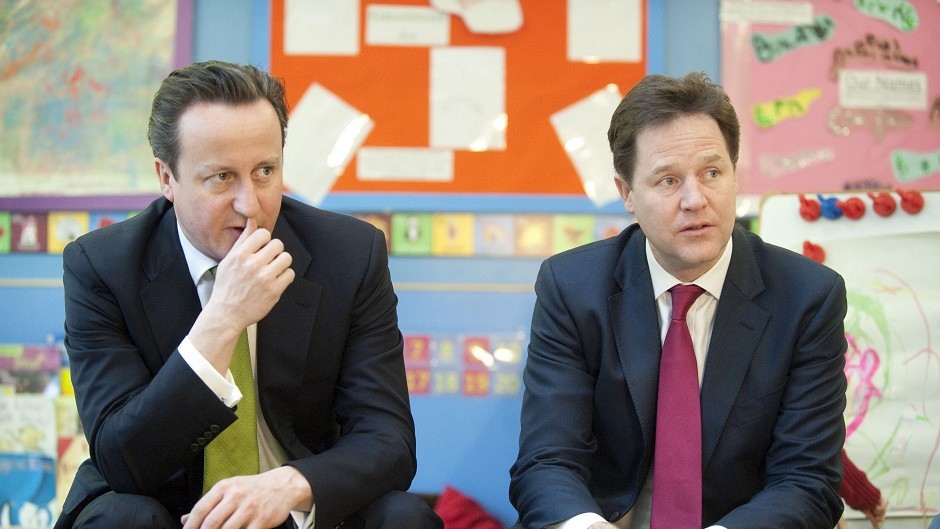Calum Ross, the P&J’s Westminster correspondent, looks at the state of the coalition on the eve of the Queen’s Speech.
As The Queen prepares to outline the coalition’s programme for its final 11 months in power, it seems right to acknowledge that few thought it would ever get this far.
Britain was left stunned in May 2010 when a hung parliament led to the first formal power-sharing alliance of its kind since 1945 being formed at Westminster.
It should be remembered that the Lib Dems were considered by many to be positioned to the left of Labour at the time, they had also not been in power since the days of David Lloyd George, and were not renowned for internal party discipline.
And it would soon emerge that David Cameron, already weakened by having failed to win a majority at the election after 13 years of Labour rule, had to contend with an equally rebellious euro-sceptic group on the right wing of the Conservative Party.
Many commentators predicted the coalition’s demise and a fresh election within 12 to 18 months, and on several occasions during that time they appeared likely to be proved correct.
Within weeks of the pact the scale of the Treasury’s spending cuts and the furore over the tuition fees U-turn alarmed some Lib Dem MPs
A year after the deal there were more Lib Dem recriminations after the Tories campaigned hard and successfully against the introduction of the AV voting system for Westminster elections in a UK-wide referendum.
Scottish Secretary Alistair Carmichael revealed to the Press and Journal that during his time as Lib Dem chief whip the only moment he genuinely feared the coalition’s collapse was in December 2011 – when Mr Cameron vetoed an EU treaty change to tackle the eurozone crisis.
Then in 2012 there was a row over Mr Clegg’s decision to block a shake-up of the Westminster constituencies, a move which would have removed an in-built Labour bias in the system, with the Lib Dems sinking the plans in retaliation for the Conservatives failing to back House of Lords reform.
More recently, research has shown that of the 68 post-war Commons sessions before 2013-14, there were just six that featured more rebellions by government MPs than last year.
But while members of the respective parties have routinely resumed their traditional hostilities, they have never really seemed likely to go their separate ways.
For the Lib Dems in particular, while the principal stated aim of the alliance was to provide a stable environment for the restructure of the economy, the key political goal was to prove that coalitions could work at Westminster.
While there is still time for the two parties to part company in a “conscious uncoupling” or bitter war of words over the coming weeks and months, and they have been growing more and more disparate, the coalition has already lasted far longer than many had predicted.
But saying it has proved the doubters wrong over its durability is not the same as judging it a success.
The two parties would no doubt point, with some justification, to positive indications of economic recovery.
And from a Scottish perspective, it may well be that the historians highlight the presence of so many Scottish Lib Dem MPs in government as a key factor in the independence referendum, if the No camp retains its poll lead.
(Imagine if the Conservatives had won a majority in 2010 and the UK Government had just one Scottish MP during the independence debate.)
However, if the coalition had been such a triumph then Mr Clegg would not have the air of a man whose career is already over, and Mr Cameron would not be facing the prospect of being Britain’s first one-term prime minister since Edward Heath.
In truth they have had little option to walk away from each other because the Lib Dems would have risked wipe-out in a snap election, and Labour could have ousted the Conservatives in any vote.
Looking forward to what will follow the coalition after May’s election, the polls suggest Britain is heading for another hung parliament.
If borne out, the Tory-Lib Dem pact could well be renewed for another term, or Labour could seek to strike a deal to return to power. Much will depend on the numbers.
But there are also signs that this coalition has been such a bruising experience for both parties, that either the Conservatives or Labour would look first to govern on their own in a minority administration.
This coalition may have proven that such alliances can go the distance at Westminster, but the irony is that the experience of the last few years may also have made them less likely to happen in the future.
